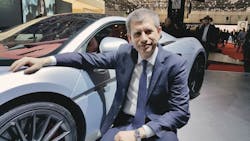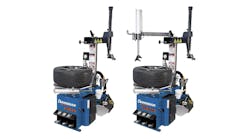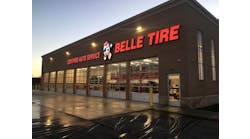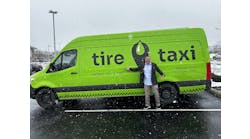Pirelli & Cie SpA used the 2016 Geneva Motor Show to showcase its presence in the “prestige” and “premium” segments of the European car market and announce that it is introducing new P Zero tires to the marketplace during 2016.
“Pirelli has devoted 100% of its booth at the 86th Geneva Auto Show to its new P Zero brand.” Those were the comments by Matteo Battaini, head of marketing and supply chain for Pirelli & Cie SpA. Battaini says the P Zero “is a brand within a brand.”
In reality, Pirelli did not “launch” the new P Zero at the show. Instead, the company announced the new tires have 56 original equipment homologations. At the replacement level, the P Zero, in three versions designed for three different types of vehicles, will be introduced starting this month.
At the Geneva Show, Pirelli’s Gregorio Borgo, director of general operations, said his company had 51% of the prestige vehicle fitments and 32% of the premium vehicle fitments. Pirelli considers vehicles such as Lamborghini, McLaren, Ferrari, Pagani and other exotic vehicles as prestige. Most BMWs, some Porches and Audis are examples of premium vehicles.
Borgo said these two segments are growing at a much faster rate than standard fitments, and those are the areas where Pirelli wants to compete. He pointed to research in Europe that prestige vehicles are growing at seven times the rate of standard vehicles, while premium vehicles are growing at three times the rate.
Another study in Europe showed that although 84% of consumers do not know what an OE homologated tire is, once the difference is explained to them, 46% of them say they would pay more for that tire and 32% said they may pay more. No research for North America was discussed by Pirelli.
Pirelli is “living in the prestige market and doing well in premium,” according to Borgo.
Currently the P Zero lineup includes 500 items with 800 homologations achieved. The company said it has already sold 80 million P Zero tires worldwide, and it is projecting another 20 million tires will be sold by 2018.
When the new P Zero tires enter the lineup, Pirelli does not intend to quit producing the previous P Zero tire lines. In fact, Borgo thinks there will be a 50/50 split between the new and old P Zeros sold in 2017, with the new tires then outpacing the older tires moving beyond that time frame.
The philosophy that Pirelli is promoting may best be summed up this way. Borgo said 20% of the company’s volume, 45% of its turnover and 64% of its EBIT (earnings before interest and taxes) comes from 18-inch and above tire sizes. The new Pirelli P Zero will be available to consumers globally this month although the tire has already made its way to prestige and premium vehicle OEMs.
It will be introduced in three different versions destined for three different types of cars:
- P Zero for top-of-the-range sports cars.
- P Zero for high performance sedans.
- P Zero Corsa for supercars.
The difference between the first two types of tires is mainly seen in the tread pattern, according to Pirelli. The tire for sports cars has fewer tread blocks to enhance vehicle dynamics, while the high performance saloon (sedan) car tire has a grooved external shoulder to put the accent on comfort.
It’s not just in terms of tire sizes that the P Zero range is becoming wider and more specialized. There are also specific winter, summer and all-season tires within these categories. On the tire’s interior, Pirelli has introduced new technologies, such as run-flat, seal inside, and PNCS (Pirelli Noise Cancelling System): a system that reduces cabin noise.
Pirelli is also doing ongoing research into alternative materials, from rice husks to guayule.
Finally, Pirelli has what it calls branded tires. The company believes a BMW makes different demands of its tires compared to a Volvo, while the performance characteristics of a Lamborghini are different than those of a Maserati. The company puts small brands for its OE tires on the sidewalls of its tires to drive home this point.
Pirelli has chosen the path of individuality for its tires, stating that the real value lies in giving drivers choice. Diversity and personalization to master the increasingly complex demands of the latest cars are the watchwords of Pirelli’s strategy.
These two aspects are what Pirelli uses for its original equipment homologations, especially in the premium and prestige sectors. To develop just one product, suitable for a single vehicle, takes two or three years of close collaboration between Pirelli’s engineers and those of the car maker.
“The close relationship with Pirelli’s Formula 1 tires can be seen in the new Corsa, which is very similar to a motorsport slick.”
Pirelli engineers began designing the original P Zero in 1986. In 1987, it became Pirelli’s first ultra-high performance tire, and was a 17-inch OE fitment on the Ferrari F40. ■




